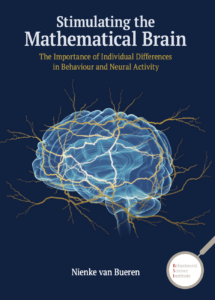Proefschrift Nienke van Bueren

Nienke van Bueren |
Stimulating the mathematical brain: The importance of individual differences in behaviour and neural activity
Radboud Universiteit, Nijmegen |
|
Samenvatting
Het is misschien wel het meest fascinerende orgaan van ons lichaam: het menselijk brein. Niet alleen is dit orgaan erg complex, maar de interactie tussen hersenfunctie en gedrag is iets wat nog niet goed in kaart is gebracht. Omdat niet elk brein hetzelfde is, zijn er veel verschillen tussen mensen, wat zich ook kan uiten in verschillende gedragingen. Een veelbelovende methode die ons kan helpen begrijpen hoe hersenactiviteit van invloed is op gedrag is hersenstimulatie.
Hierbij wordt er meestal een klein elektrisch of magnetisch veld opgewekt op het hoofd om zo het onderliggende neurale gebied te beïnvloeden (zie Figuur A.1). Dit is een niet pijnlijke en veilige methode. De afgelopen jaren zijn er veel studies gedaan waarin hersenstimulatie wordt toegepast om gedrag te veranderen. Zo kan hersenstimulatie tijdelijk het werkgeheugen vergroten en iemand sneller en accurater laten rekenen (Brunoni & Vanderhasselt, 2014; Schroeder et al., 2017). Daarnaast is het ook een interessante interventie voor klinische doeleinden zoals verlichting van depressie en Parkinson (Jorge & Robinson, 2011; Schulz et al., 2013).
Abstract
This PhD thesis focuses on using brain stimulation to increase people’s arithmetic skills and to examine the underlying neural processes. Transcranial electrical stimulation (tES) is a technique capable of mapping the relationship between behaviour and brain function. A major limitation of brain stimulation is that it does not take into account differences between people. In the first two chapters, it becomes clear that individual differences are not accounted for in studies using brain stimulation as a numerical intervention. The next chapter examines several studies that aim to improve learning in dyscalculia and dyslexia. Two other studies show that there are both important behavioural markers (baseline numeracy) and neural markers (excitation/inhibition levels) for the efficacy of tES. One of these studies also shows the importance of personalising brain stimulation, thereby emphasising individual differences using machine learning. The final chapter shows that the way researchers analyse electrophysiological (EEG) data matters and is important when drawing conclusions in relation to behaviour. In short, brain stimulation is an effective method to influence numeracy and learning processes. Individual differences are also important.
Verwijzingen
- Van Bueren, N. (2023). Stimulating the mathematical brain: The importance of individual differences in behaviour and neural activity Radboud University. Nijmegen.



